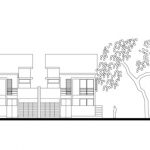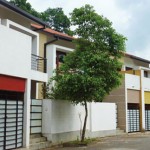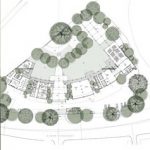-
Arangala Housing Scheme: Built to Impress
October 2010
By Thilini Kahandawaarachchi | Photography by Upula Chandrakumara
“Imagine designing a house for an imaginary resident”, that was the brief given to Architect duo Upula Chandrakumara and his wife Amanda Rajapakse. Yet, they were tasked with not just designing one house, but an entire housing scheme comprising of 27 houses in Arangala, Malabe. In response, they came up with a collection of compact and modern houses best suited for urban living.”

Situated in suburban Malabe, the project site was a large plot of land subdivided into linear plots with a frontage of approximately 30ft. The Architects were required to use their creativity and skill to bring harmony between these plots with varying typology and shapes to come up with a housing scheme that had a harmonious overall design.
Keeping in mind the diverse requirements of the potential residents, four prototypes of houses of varying sizes, with subtle differences in exterior, massing and internal layouts were designed. Each house in the scheme comprises of three bedrooms and other amenities required for comfortable living. The 30ft frontage of the plot only allows a single car-parking slot for each house and though the houses were built as separate units that mirrored each other, the adjoining carports are attached. As the house rises and reaches the upper levels, the carports are detached.
To suit the linear plots, the design of the houses was divided into segments with intermediate spaces. The house opens into the living area and a courtyard separates it from the dining area, which again opens up to the rear garden. Some houses come with a courtyard on the side of the dining area that adds more character to the space. The ground floor also accommodates the pantry, a bedroom and a driver/maid quarters.
From the front door, one can see up to the rear garden, preventing the house from being visually blocked, allowing in ample light and air. On the upper level, each house has three bedrooms with the master bedroom facing the roadway. The master bedroom has an attached bathroom and the residents were given the option of removing the wall between the two other bedrooms to make it one big bedroom.
Reflective materials were used in the design and construction so that the light inside the house was enhanced. Pastel colours and white were used to give more of a sense of space and light. The use of large floor tiles has also added to the spacious feeling. Though a housing scheme comprising of similar houses, different colours have been used on the exterior to give each house a unique identity to differentiate one another, yet making them part of the holistic design of the scheme.
The high sloping roofs of the houses give them the right proportion while also adding volume to the space inside.
Water tanks and such are neatly tucked under the high roof while some houses are designed with double height and others have two roofs, which result in a verandah. The long sloping roofs and eves protect the balconies, while louvers and awnings were used to shade the balconies so that the residents can spend time on the balcony at anytime during the day.
Though the designs of the houses are strikingly modern, the architects have not compromised on quality, sustainability or weather protection. The timber doors and windows are both higher and thicker than the usual sizes. High roofs, airy spaces and the colours have ensured that the homes suit local climate. The timber and glazing used in the design are padded to protect them from the possible vibrations of the operations of the nearby quarry. Though initially the plan was to build 31 houses, the client was convinced to set-aside certain plots as a play area for the children and a common area for the residents.
According to Upula, the buyers have been discouraged from changing the exterior of the houses, as the concept was to consider the scheme as a holistic design with the units combining to express its overall character. However, flexibility has been given to the owner to make changes to the interior.
Speaking of the challenge of designing a house for a resident who they did not have the chance to meet, Upula says, “what we did was design more or less to a formula where the resident’s needs and aspirations expectantly fitted into that formula. If the buyer was impressed with the facilities provided, the spatial articulation, massing and overall ambience generated, they decided to inhabit that abode.” Today, a few years after completion, this housing scheme at Arangala is fully occupied.
Principle Architects: Archt Upula Chandrakumara and Archt Amanda Rajapakse
Structural engineer: Ranjith Wijegunasekara
Electrical Engineer: Rohitha Senanayake
Plumbing Engineer: Nimal Perera
Landscape, interior finishes: Archt Upula Chandrakumara and Archt Amanda Rajapakse
Draughtsperson: Sidath Madulanka
Square area of the site: 350 perches
Total no. of units: 27
Approx extent per land plot: 10 perches
Square area of the project: 65,000 sq ft
Date of completion: 2006
Project period: two years
Contractor: Kaluthota Construction, PDL Construction
Client: F&G Property Developers
















